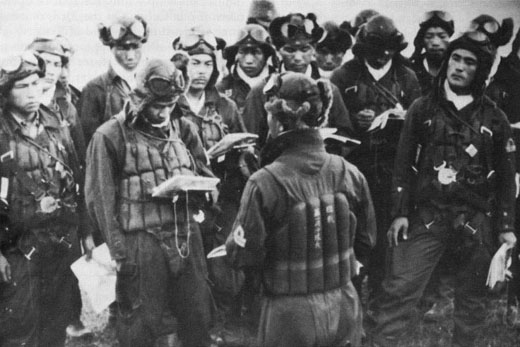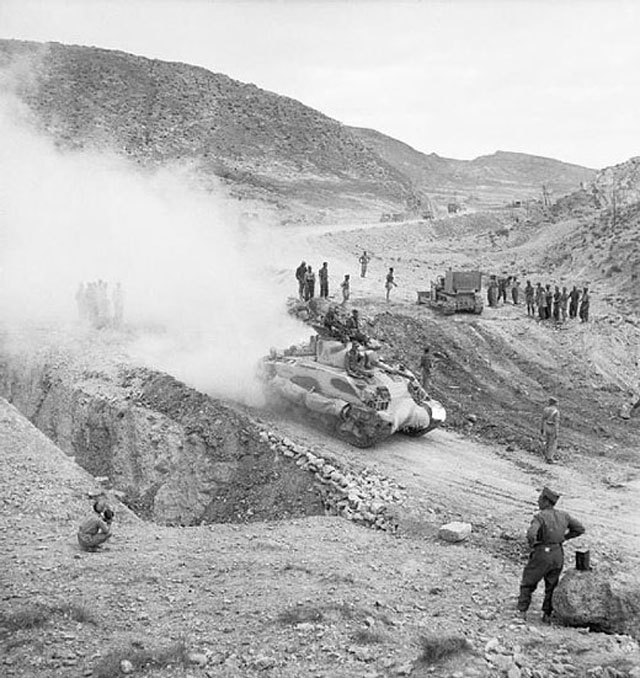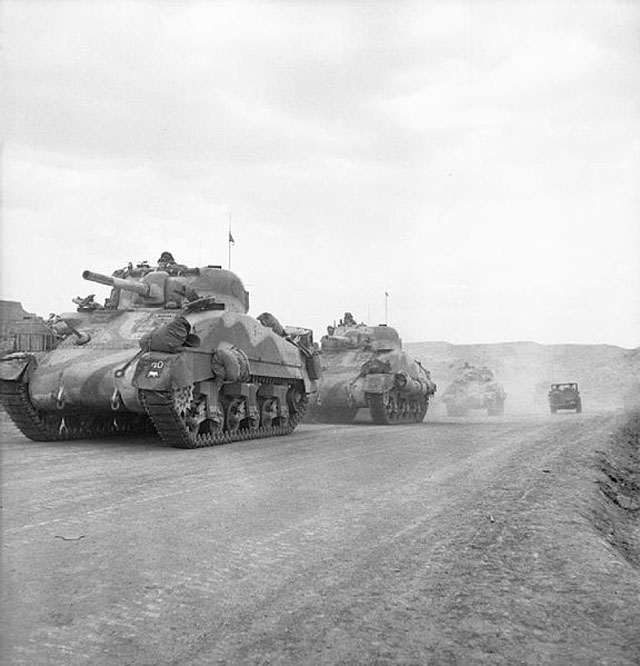Air Operations, Bismarcks
43rd Heavy Bomb Group B-17s and 90th Heavy Bomb Group B-24s mount individual attacks against Cape Gloucester and Kavieng.
[Air Operations, CBI
BURMA- 6 7th Heavy Bomb Group B-24s attack a Japanese Army headquarters at Toungoo.
- 18 341st Medium Bomb Group B-25s attack a marshalling yard at Ywataung.
- 2 B-25s attack a rail bridge at Ye-u.
- 51st Fighter Group P-40s support Allied ground forces near Shingbwiyang.
Air Operations, New Guinea
- 90th Heavy Bomb Group B-24s attack Fak Fak and the Babo landing ground.
- B-24s and 43rd Heavy Bomb Group B-17s mount individial attacks against Finschhafen, Lae, Lorengau, Salamaua, and Wewak.
Air Operations, Sicily
IX Bomber Command B-24s attack Palermo harbor.
[Air Operations, Solomons
In the second phase of Operation I GO, 67 D3A 'Val' dive bombers, escorted by an estimated 117 A6M Zeros—all borrowed for this assignment from Japanese Navy aircraft carriers—attack Allied shipping off Guadalcanal at about 1400. Though challenged by 36 AirSols F4Fs, 9 F4Us, 12 P-38s, 6 P-40s, and 12 P-39s, the 'Vals' are able to complete numerous bombing attacks that sink a US Navy oiler, a destroyer, and a Royal New Zealand Navy corvette. 12 'Vals' and 15 Zeros are shot down by VMF-213, VMF-214, and VMF-221 F4Fs. 7 F4Fs and P-38s are also shot down with the loss of only 1 pilot.
[Air Operations, Tunisia
Although NASAF bombers are grounded by bad weather, IX Bomber Command, IX Fighter Command, XII Air Support Command, and the WDAF mount an all-out effort to harrt German Army forces retreating before massive Allied ground attacks throughout Tunisia. USAAF fighter pilots, involved in numerous escort and ground-support missions, down 3 Bf-109s during at least three fighter actions.
[Axis Planning
Hitler and Mussolini meet at Klessheim Castle near Salzburg. Dönitz is also in attendance. They discuss the military situation in the light of the severe defeat of Axis troops on every front. Hitler does most of the talking mostly about a new German offensive in Russia. Among the subjects for their discussion is, of course, the situation in North Africa. Mussolini wants Hitler to sue for a separate peace with Russia so as to be able to reinforce the south European front. But the Führer will have none of it. He enchants Mussolini with fantastic stories of future victories, even in Africa. 'Duce,' he tells him, 'I guarantee you that Africa will be defended. Verdun stood out against the attack of the best German regiments. I do not see why we should not stand out as well in Africa. With your help, Duce, my troops will make Tunis the Verdun of the Mediterranean.' Mussolini allows himself to be persuaded. Hitler is concerned about Mussolini's physical condition and tells Dönitz he wonders whether the Duce has the will 'to carry on to the end.' The conference lasts 4 days.
[Britain, Home Front
The Keynes' Plan for an international banking agreement is published.
[Diplomatic Relations
- Bolivia declares war on Germany, Italy and Japan.
- Maxim Litvinov arrives in Havana to become the first Soviet Minister to Cuba.
Eastern Front
The whole front has come to a halt with the thaw. But Hitler demands that preparations should be hastened for a big offensive to start the moment conditions permit. He plans to break through the great Russian salient at Kursk at its base and wipe out the huge forces concentrated there. The Russians, foreseeing this obvious move by the Germans, are fortifying the salient with at least 8 concentric defensive lines and hundreds of thousands of mines, preparing methodically for what may well be the biggest battle of the whole war.
[Mediterranean
The submarine Rorqual and the minelayer Abdiel lay minefields off Tunisia to hamper Axis troop convoys.
[New Guinea
In a similar raid to the one being carried out against shipping off Guadalcanal, 2 transports are sunk off New Guinea.
[North Africa
TUNISIAThe Axis forces are retreating rapidly from the Wadi Akarit position towards Enfidaville. The British 9th Bde attacks Fondouk Pass. Advance units of 8th Army meet patrols from the US 9th Div of Patton's Corps not far fram Graiba on the road toward Gafsa.
All available aircraft of the XII Air Support Command and the Western Desert Air Force attack the enemy, who is retrating in all sectors. The IX Corps completes its preparations for an assault on Fondouk, designed to block a northward retreat of the enemy from the Akarit line. Commanding officers reach an agreement on the final details and decide to open the attack at 0300 on the 8th. The US II Corps makes contact with the British 8th Army and the Southeast Algerian Command on the Gafsa-Gabès road. Task Force Benson, ordered to push forward relentlessly and without regard to cost, advances steadily to the southeast toward Gabès and in the afternoon makes contact with the X Corps of the British 8th Army, then pulls back to help mop up. The 9th Div begins a movement to the Bou Chebka area during the night, turning over its sector to the 1st Div, which is to conduct mopping up operations.
|
|
The British 8th Army, with the XXX Corps on the right and the X Corps on the left, pursues the rapidly retreating enemy northward to the general line Cekhira-Sedkret en Noual.
In the British 1st Army area, the V Corps opens an offensive to clear the Bédja-Medjez el Bab road and thereby remove the enemy threat to Medjez. The 78th Div, with close air and artillery suppoort, begins an attack north of Oued Zarga.
[Pacific
- The US submarine Tunny (SS-282) torpedoes the Japanese stores ship Kosei Maru (2170t) about 250 miles northwest of Truk. The ship sinks while it is being towed to Truk.
- The US submarine Pickerel (SS-177) sinks the Japanese cargo ship Fukuei Maru (1113t) near Shiriya Zaki, Honshu. It was after this sinking that the Piokerel is lost to unknown causes.
Solomons
In an attempt to set back American preparations, Yamamoto decides to mount an all-out air offensive to be known as Operation I(?). The 11th Air Fleet based on Rabaul, Kavieng and Buin is reinforced by the pilots and aircraft from the carriers Zuikaku, Shikaku, Junyo and Hiyo, leaving the fleet with almost no trained pilots. The attacks begin with a raid against Guadalcanal and Tulagi by 188 planes, 71 bombers and 117 fighters. A savage air battle develops, in which the Americans lose 7 fighters and the Japanese considerably more. The attackers succeed in dealing an effective blow sinking the US destroyer Aaron Ward (DD-483), the tanker Kanawha (AO-1) and the New Zealand corvette Moa are sunk.
Japanese Naval Pilots |
 |
United States, Home Front
Secretary of Treasury Henry Morgenthau's Plan for the stabilization of international finance is published by the Office of War Information.
[
